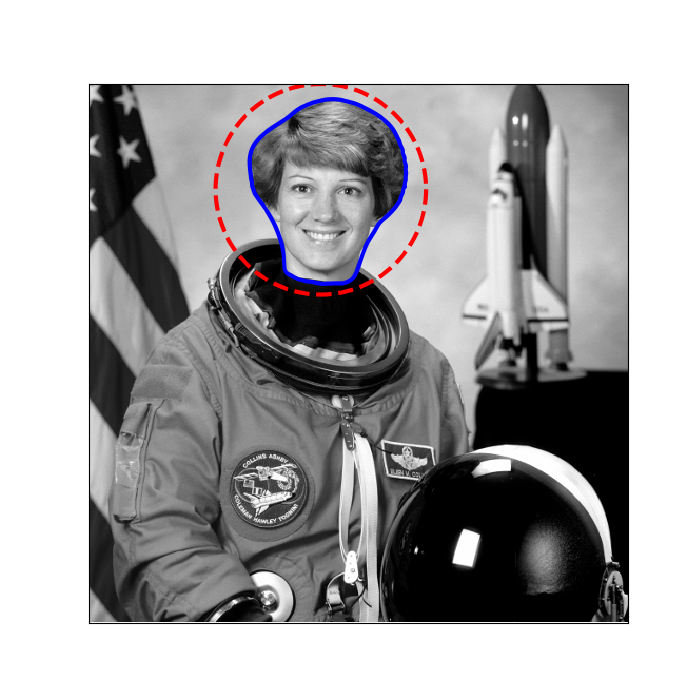
The active contour model is a method to fit open or closed splines to lines or edges in an image [1]. It works by minimising an energy that is in part defined by the image and part by the spline’s shape: length and smoothness. The minimization is done implicitly in the shape energy and explicitly in the image energy.
In the following two examples the active contour model is used (1) to segment the face of a person from the rest of an image by fitting a closed curve to the edges of the face and (2) to find the darkest curve between two fixed points while obeying smoothness considerations. Typically it is a good idea to smooth images a bit before analyzing, as done in the following examples.
We initialize a circle around the astronaut’s face and use the default boundary
condition bc='periodic' to fit a closed curve. The default parameters
w_line=0, w_edge=1 will make the curve search towards edges, such as the
boundaries of the face.
| [1] | Snakes: Active contour models. Kass, M.; Witkin, A.; Terzopoulos, D. International Journal of Computer Vision 1 (4): 321 (1988). |
import numpy as np
import matplotlib.pyplot as plt
from skimage.color import rgb2gray
from skimage import data
from skimage.filters import gaussian
from skimage.segmentation import active_contour
# Test scipy version, since active contour is only possible
# with recent scipy version
import scipy
split_version = scipy.__version__.split('.')
if not(split_version[-1].isdigit()): # Remove dev string if present
split_version.pop()
scipy_version = list(map(int, split_version))
new_scipy = scipy_version[0] > 0 or \
(scipy_version[0] == 0 and scipy_version[1] >= 14)
img = data.astronaut()
img = rgb2gray(img)
s = np.linspace(0, 2*np.pi, 400)
x = 220 + 100*np.cos(s)
y = 100 + 100*np.sin(s)
init = np.array([x, y]).T
if not new_scipy:
print('You are using an old version of scipy. '
'Active contours is implemented for scipy versions '
'0.14.0 and above.')
if new_scipy:
snake = active_contour(gaussian(img, 3),
init, alpha=0.015, beta=10, gamma=0.001)
fig = plt.figure(figsize=(7, 7))
ax = fig.add_subplot(111)
plt.gray()
ax.imshow(img)
ax.plot(init[:, 0], init[:, 1], '--r', lw=3)
ax.plot(snake[:, 0], snake[:, 1], '-b', lw=3)
ax.set_xticks([]), ax.set_yticks([])
ax.axis([0, img.shape[1], img.shape[0], 0])

Here we initialize a straight line between two points, (5, 136) and (424, 50), and require that the spline has its end points there by giving the boundary condition bc=’fixed’. We furthermore make the algorithm search for dark lines by giving a negative w_line value.
img = data.text()
x = np.linspace(5, 424, 100)
y = np.linspace(136, 50, 100)
init = np.array([x, y]).T
if new_scipy:
snake = active_contour(gaussian(img, 1), init, bc='fixed',
alpha=0.1, beta=1.0, w_line=-5, w_edge=0, gamma=0.1)
fig = plt.figure(figsize=(9, 5))
ax = fig.add_subplot(111)
plt.gray()
ax.imshow(img)
ax.plot(init[:, 0], init[:, 1], '--r', lw=3)
ax.plot(snake[:, 0], snake[:, 1], '-b', lw=3)
ax.set_xticks([]), ax.set_yticks([])
ax.axis([0, img.shape[1], img.shape[0], 0])
plt.show()

Total running time of the script: ( 0 minutes 0.745 seconds)